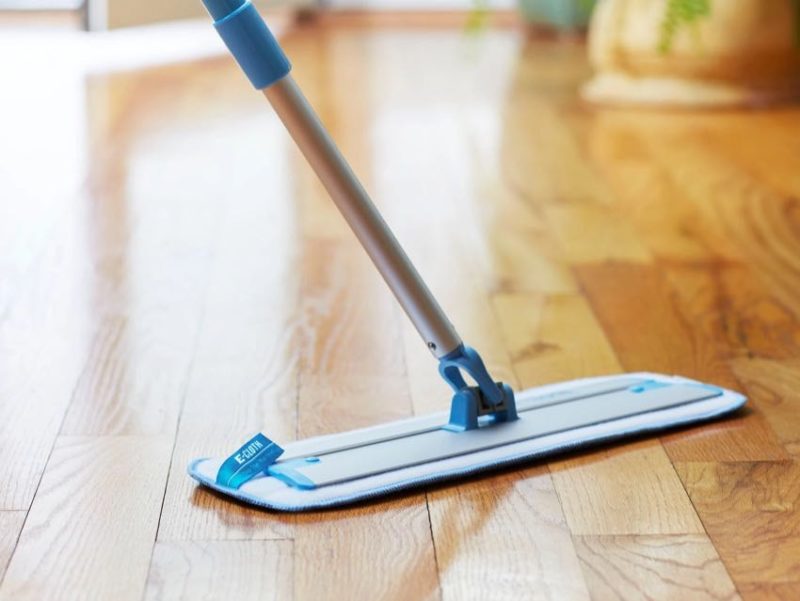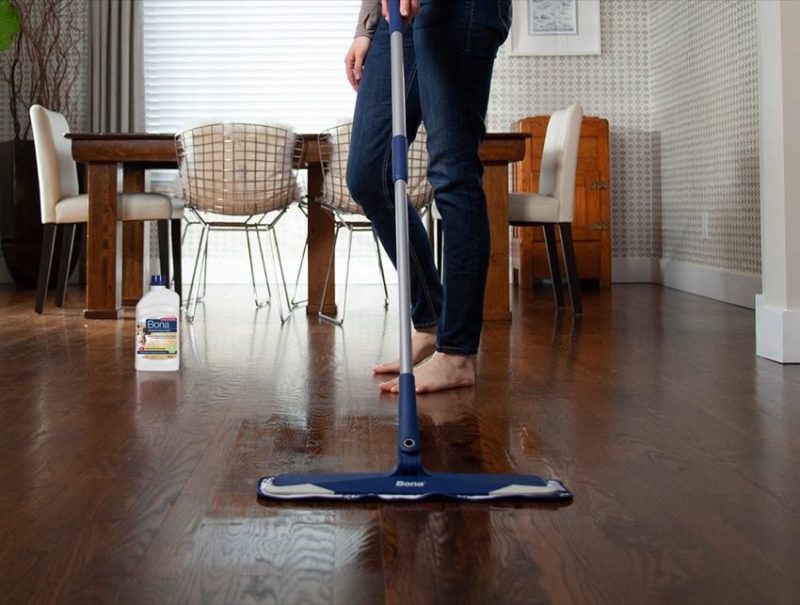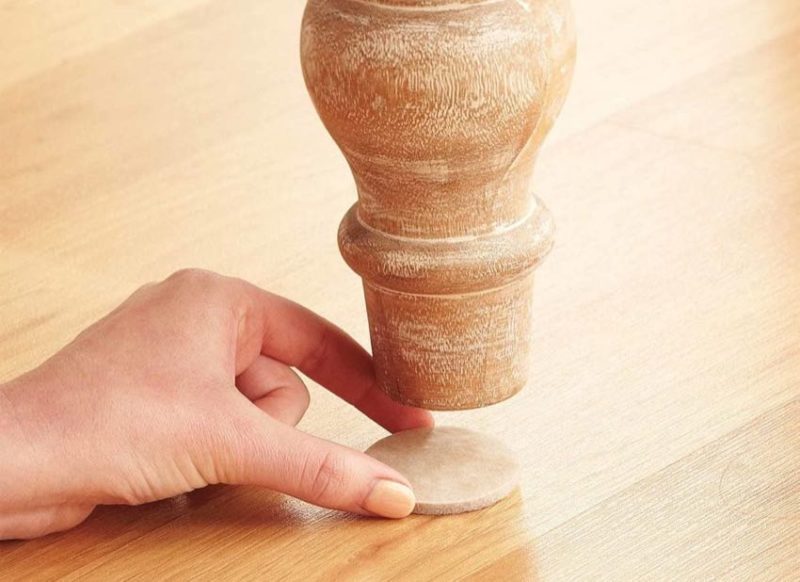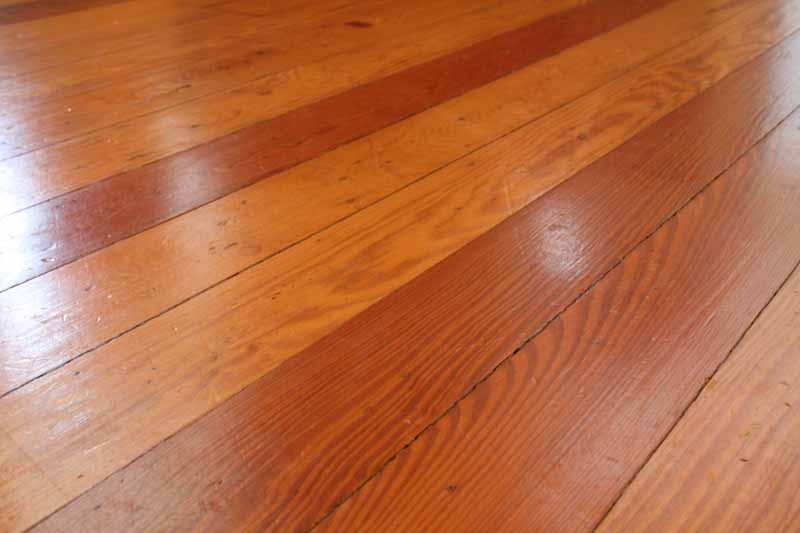Whether you just purchased a home with wood floors or you’ve recently decided to repair and replace wood flooring, you want to protect your investment. It’s important to learn a bit about proper wood floor care so you can protect and prolong the beauty of your wood floors. Regardless of what kind of hardwood you put down, knowing how to care for wood floors can really make the difference between a great-looking floor and one that wears prematurely. With that in mind let’s begin taking a look at some of the basics that apply to nearly every hardwood floor.
Set a Schedule for Wood Floor Care
If you keep up with wood floor care, you won’t get overwhelmed. Start with a weekly cleaning plan. Don’t be afraid to clean more frequently—but dusting may be sufficient for any sort of daily care. Regular weekly cleaning plays an even more important role up north. Ice, snow, and mud can wreak havoc on a wood floor over time.

Keep your wood floors clean, and you can rely on them for many years. We prefer products designed specifically for wood floors. If you have any concerns, you can test out the cleaner in a closet or somewhere any poor results won’t be as noticeable.
Polish Protects Wood Floors Over the Long-term
Sunlight and traffic simply work to dull wood floors over time. They erode and destroy any protective coatings if you don’t regularly clean and care for your wood floors. To guard against this, we recommend putting a coating of polish on your wood floors 2 times per year. Some people recommend more applications—but that depends on the product used.

You can find excellent hardwood floor care and cleaning products at most retailers, including Lowe’s, Home Depot, and Amazon.
Deal With Hardwood Floor Spills Quickly
Water is the number one detriment to hardwood floors in most homes (along with other spilled liquids). If you were involved in the selection of your hardwood floor, you probably know the destructive nature of unwanted moisture. Even when choosing a flooring product this makes a difference in the type of material you should install.
Water on the topside of a hardwood floor can be destructive not only to the structure in the long term but also to its beauty in the short term. Dry your floors immediately if there is a spill.
What to Avoid When Caring for Wood Floors
Don’t Use Water
We recommend against cleaning wood floors with water—that includes laminate or engineered floors. While some flooring claims to be waterproof for long periods of time—you never know when you might have gaps or places of entry where moisture can penetrate.
As we recommended above, you really want to keep dust and grime off of your floors. Knowing how to clean wood floors is an important part of caring for them. However, when you clean your wood floor, don’t use water. Instead, use either a dust mop or—at the very least—a broom that features exploded tips. These broom tips help to trap the dust when you sweep while avoiding the necessity of frequently wet mopping.
Avoid Using Beater Brushes on Vacuums
Along with the broom recommendation, don’t use beater brush vacuums—just suction. Some vacuums let you disable the brush for non-carpeted flooring. The aggressive brushes can cause damage over time and you really don’t need them on wood floors.
Never Use Steam Mops or Cleaners
It may seem obvious, but never use a steam mop or cleaner on your wood floors. We’ve heard some wild stories and recommendations on using those to rid floors of stains. While sealed floors can probably handle it, many engineered floors have glues and bonding agents that could suffer negative effects. You could also encounter areas of your “sealed” wood floor that don’t bear up well under that kind of treatment.
And if you use a steam mop on a laminate floor, you might completely bubble up the edges of the top layer—resulting in a completely ruined floor. In the end, that simply isn’t a method we recommend—best to avoid them entirely.
Watch Those Shoes and Pet Nails!
You don’t hear about shoes all that often when talking about hardwood floor damage, but wait until you have kids and they walk in wearing cleats! You can also damage floors with stilettos and other really narrow heels. Just be aware of how hard shoes can damage your flooring over time. Pay particular attention to entryways.
You can try small area mats at the entrances to clean off shoes. These can be very effective at preventing a majority of dirt from being tracked in. As with most things, preventing a problem is better than correcting a problem. With that in mind, you may even want to start taking off your shoes when entering the house. We’ve had that practice for years and it works pretty well.
Also—keep the nails trimmed on your dogs and cats. You’d be surprised how that can affect the look of your wood floor over time!
Add Felt-Bottom Furniture Pads to Prevent Scratches
Your furniture may also cause damage to your floors. One easy way to prevent that damage is to place glides with fabric bottoms beneath the legs of your furniture. Another commonsense pointer is to simply be careful anytime you move furniture.

Don’t Use Oil-Based Polishes
Unless you like slipping and falling, stay away from oil-based polishes. I once oversprayed Pledge on a coffee table and our two boys spent the next couple of hours “ice skating” on the living room floor. The good news is I think they took care of the problem for us—and they didn’t have far to fall.
For the rest of us, creating the equivalent of “black ice” on your living room and dining room floor probably isn’t a great way to live a long and prosperous life. Aside from the slippery factor, oil-based polishes can dull your floor over time as the material tends to build up.
How to Care for Wood Floors that Get Lots of Exposure to the Sun
Sun is the next thing to keep an eye on. It may be surprising that constant exposure to the sun’s ultraviolet rays can cause discoloring. If possible, draw the curtains or close the blinds to protect your floors.
If you included some sort of UV curing or protection in your wood floor finish you have a huge advantage here. These modern solutions provide much-needed color protection from the sun’s harmful rays.
For those who have to deal with existing floors, adding UV-protective film on your sun-facing windows might be a great way to help eliminate fading of your wood floor.
Final Thoughts
The last tip for cleaning hardwood floors is to be picky about the cleaners that you use. Anytime you plan to use a cleaner, ensure that it specifically works for cleaning hardwood floors. A common characteristic of hardwood floor cleaners is that their PH is neutral. This helps avoid damage and build-up that eventually hides the luster of your floor.
Have any additional tips? If so, please leave them in the comments below.




Do you recommend putting rugs down with a latex backing on wood floors?